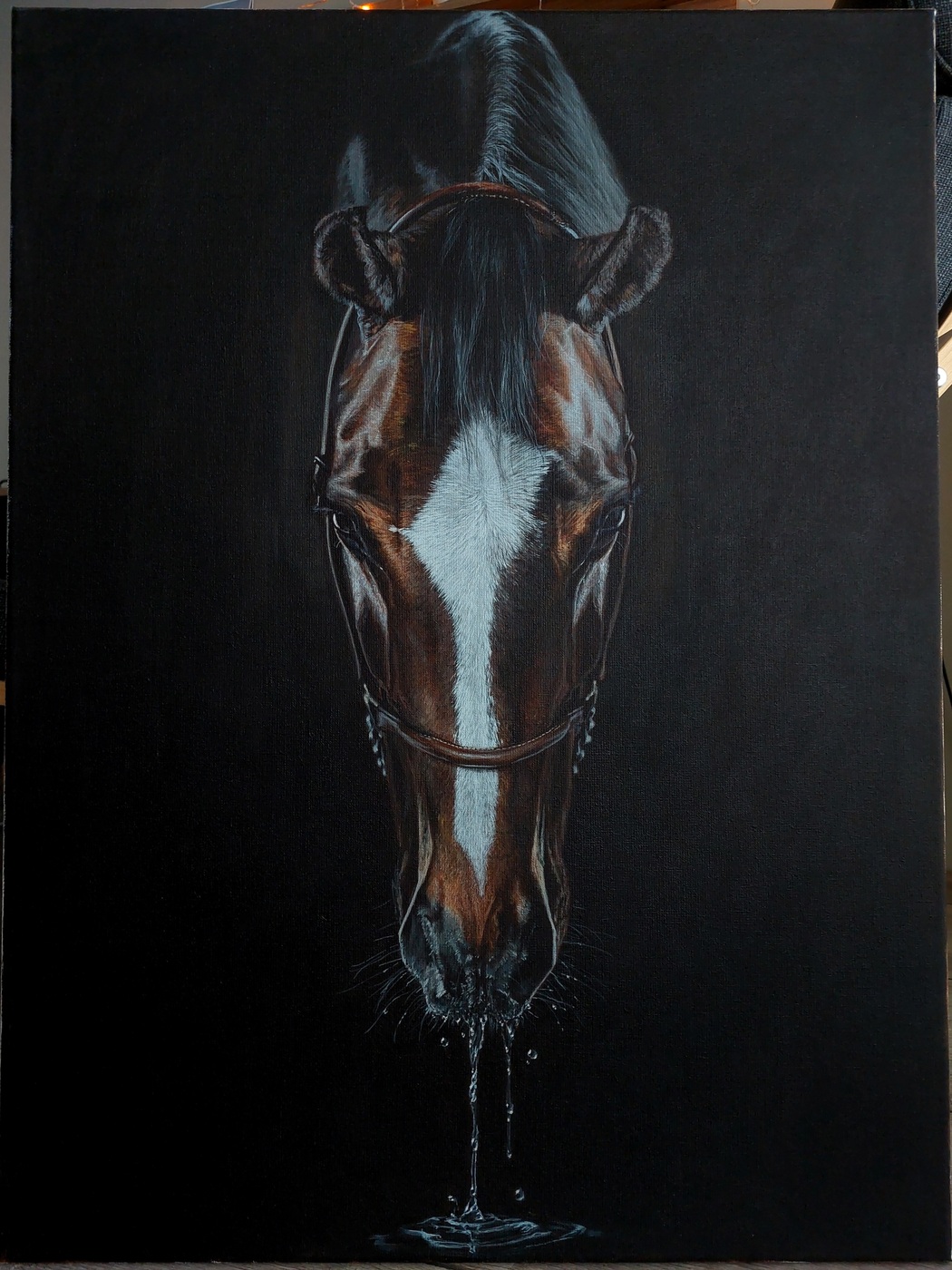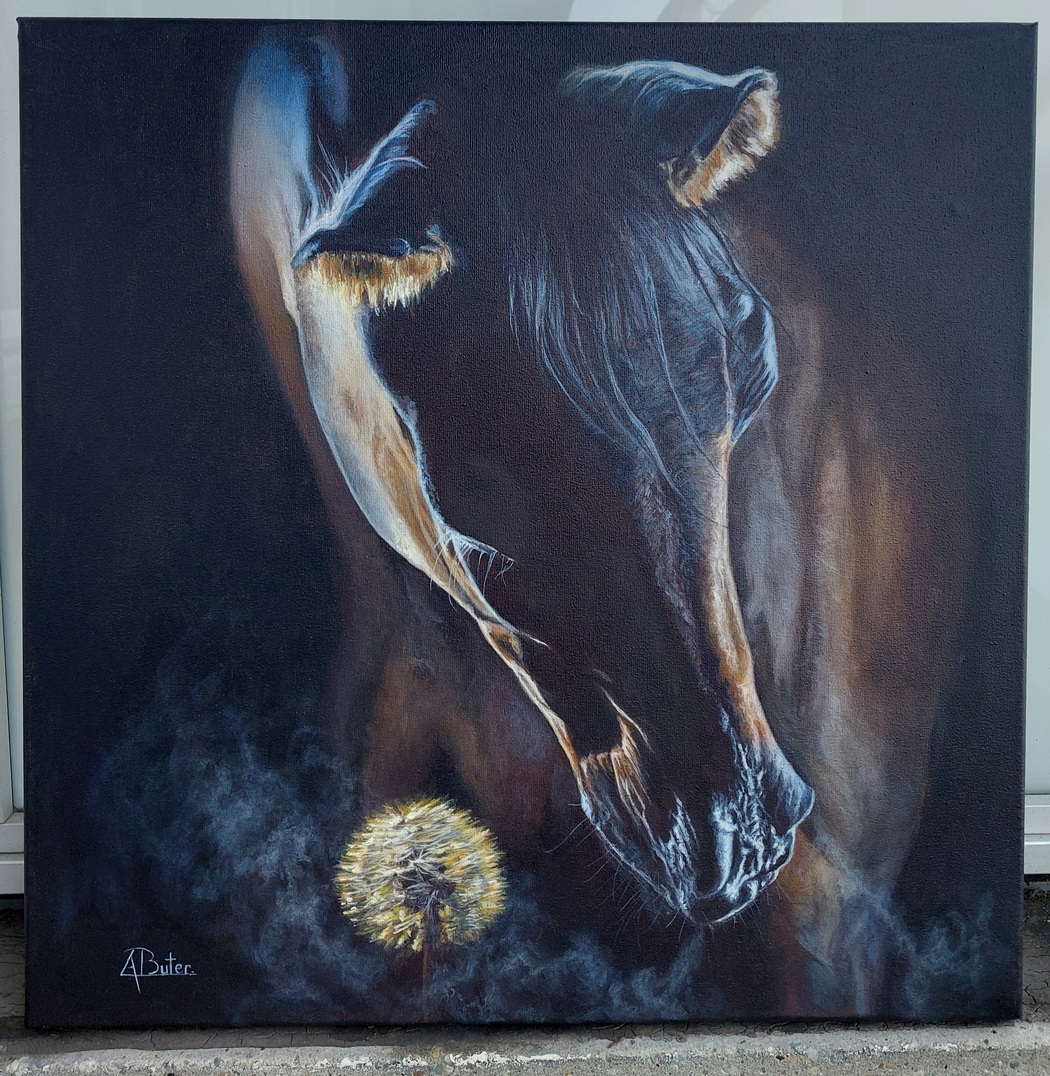Lisette Raap-Buter
Year of birth: 2002
Where do you live: The Netherlands, close to Rotterdam
Your education: I don’t have any education in art, my only education is in horse management and teaching.
Describe your art in three words: Living, captivating, moments
Your discipline: Realistic painting
Website | Instagram

How did your journey as a self-taught artist begin, and what motivated you to pursue painting?
I have always loved to draw and colour. However, I have an older sister, who was always better in it than I was. That is why my parents got me into painting, something she did not do. That way I could do something without having to compare it to my sisters’ work. At first, I made painted by numbers. After practicing quite a bit, I wanted to try without the numbers and made my first own painting on white canvas at my now best friends’ home. She had some experience painting as well, and enjoyed teaching me the ropes. After seeing the encouragement of the people around me I believed I could make some nice paintings. My first few paintings I made together with my father. I have very fond memories of us sitting together and working on paintings. Seeing examples around me, I got very motivated to get as good: I started studying videos and paintings from artists I admired. Around the age of 11 is when people started to notice that I was quite good for my age. I got asked to make paintings for friends and classmates. At age 13 I was allowed to make money off of it, which I tried. I asked one of the horse owners I knew if I could paint her horse, which started my commissions work. Since then, I have always had a waiting list of up to a year and a half.
You mention that your passion for painting and horses go hand in hand. How has your experience with horses influenced your work?
Around the same time as I started painting, I got into riding horses. This made most of my network being in the horse industry. Through word of mouth, I got my majority of commissions from horse owners or people who are in that industry. Working with horses myself, I learned all I could about their behaviour, physiology, biomechanics and exterior. For me it is not just my love for horses, but also the beauty, power, serenity and honest but forgiving nature and mirror horses hold up when you work with them. It is an escape from a busy mind when I am working with them. It is a connection without words, a connection so clear but fragile – an average one is 600kg that could seriously hurt you. Even so you can direct them with just the slightest change in energy. There is so much in those moments I experienced that I try to show a glimpse of it in my paintings.
 Lisette Raap-Buter | Drip | 2024
Lisette Raap-Buter | Drip | 2024
Can you share how you approach the process of studying a subject in such detail before creating your paintings?
Before I put my brush to the canvas, I work out a concept. Typically, I work with photos through photoshop and digital drawing apps. I add, adjust and take away until it embodies the image I have in mind. Sometimes it is a difference of millimetres whether something works or not. Working with the reference material beforehand gives me a chance to study colours, shapes and characteristics. Usually, one of these three grabbed my attention in the first place. If the drawing is not working or not portraying what I want, it most often is something wrong with one or more of these things. After that I try to figure out what is important to direct attention to. Finding what that is and fixing it enhances the painting to something truly captivating.
After your hand injury, you switched to painting with your left hand. What did that experience teach you about yourself and your creative process?
Before I got my hand injury, I used to work for hours on end completely forgetting the world around me. Due to my hand injury, I was no longer able to do so. Instead, I had to take breaks every 10-20 minutes. It taught me to work according to a schedule and that I am more efficient when I am disciplined in taking said breaks. It boosted my creative process. Ideas come flowing when I take the space and time to let them in. Also It confirmed for me that I would rather do things the hard way then not at all and that I welcome a challenge. I learned that creativity can come in a lot of different ways, as for me by painting with my non-dominant hand to find a workaround.
 Lisette Raap-Buter | Curious | 2024
Lisette Raap-Buter | Curious | 2024
You’ve been working on an equine collection for an upcoming exhibition. What themes or emotions are you hoping to convey in this collection?
Early 2026 my equine collection will be showing at Kunsthaus Weiz in Austria. “The project is organized by Pashmin Art Consortia.“ In my collection I try to let the viewer experience a variety of emotions: the feeling of looking at a beautiful sunset, the beauty, power, serenity and liberation horses can portray, all the way to what t it looks like when all that is broken down. All this while showing talent, skill and craftsmanship in extremely realistic paintings. I feel truly accomplished when viewers are moved or amazed with my work.
You use a combination of texture, color theory, and detailed lines in your paintings. How do you decide when to add texture or use fine details?
Everything on my paintings is very deliberate and has a purpose. Areas that I want to come to the forefront get more texture, sharper lines, details and some warmer tones. An almost undetectable line of a complimentary colour can really make something pop. White is not white and black is not black, I use subtle differences in tone to create a living painting. Our own eyes deceive us, which I use within my paintings as well. To me, it is all about perception. I try to use all these small intricacies to my advantage.
How do you balance realism and creativity in your work, especially when trying to capture the essence of a subject rather than just copying a reference photo?
There is an unlimited amount of reference photos. Finding the right start is already deeper than just a photo: Something in it speaks to me, creating a feeling of how I perceive the image. A subconscious version of the final work, to say it that way. I let my creativity flow and speak to me on how to enhance the parts of the painting that make me stop and look at the photo. To me the creativity comes to fruition in creating the right concept that not only embodies the essence of the picture, but elevates it to both enjoyers of art as well as random people seeing my painting.

Leave a Reply